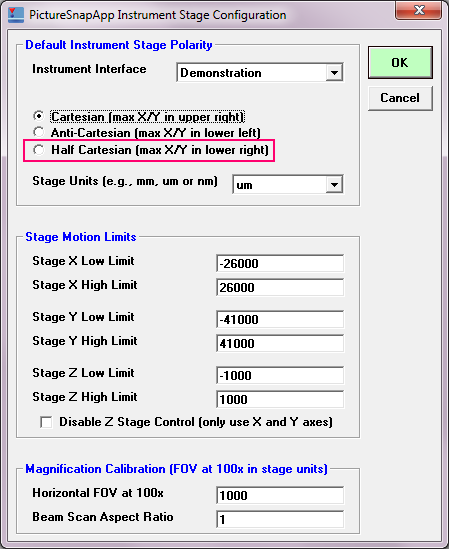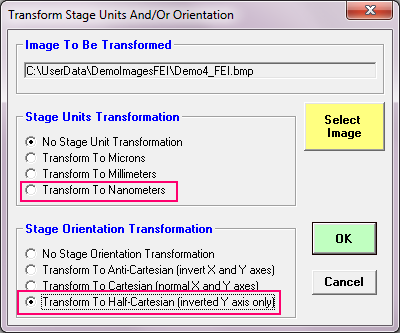Hi Nick,
Well I woke up this morning thinking of an easy way to do all this transformation stuff "on the fly"!
So now PictureSnapApp supports cartesian, anti-cartesian and now "half-cartesian" stages!


I also modified the transformation menu dialog to support transforming images from and to different units and stage orientations (I've been a busy bee) as seen here:

But the best part is that I modified the open image file code so that PictureSnapApp now *automatically* detects the stage units and orientation of the image being loaded, and then converts it to the current PictureSnapApp stage units and orientation. So the above transform dialog isn't really necessary any longer, but I left it there just in case someone can find a use for it.
This new auto-detect code should make it essentially effortless to move your images and annotations from one instrument to another.And of course PictureSnapApp also converts all the point and FOV annotations to the new stage units and orientations, but remember you'll still need to re-calibrate the image to the new stage coordinates, even if no unit or orientation conversions were necessary. That is to say, just because two instrument stages have the same units and orientation, that doesn't mean that the sample was mounted exactly the same in both instruments.
Of course, re-calibrating the image is also required if you remove the sample from the sample holder, and then remount it in the same instrument. Although in this case the image calibration will probably be very close to the saved calibration making it really easy to do (unless you mounted the sample in a different place in your sample holder). But this is all normal and expected.
This new version also supports nm (nanometer) units (I'm thinking of TEMs, but maybe they all use mm and um units?). Anyway, nm are now supported.
When you install this new version, it might force you to re-specify the stage parameters. I don't think it will but I had to modify the installer slightly so it's possible. Anyway, I will be very interested to see what you think of the recent changes... just update from the Help menu and all should be good to go.
Oh, I should also mention that if the software detects that it needs to transform the stage units and/or orientation, it automatically appends some text on the image name to make it clear what things were modified. For example if the image was converted to um, it appends a "_to_um" to the original image file name. In a similar manner, if the stage orientation was converted from cartesian orientation to anti-cartesian orientation, it would also append a "_to_anti-cartesian" string to the original image file name. That way the original image is not modified.